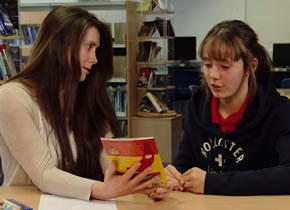
Request a full Catch Up® information brochure and details of our free information webinars
Find out more
Catch Up® Literacy and Catch Up® Numeracy have been designed for learners aged 6-14, and are needs-led, process-based interventions, which allows the supporting adult to address each individual learner’s needs (including the use of age-appropriate resources and activities) whilst keeping to the proven structure of the 15-minute session.
Catch Up® Numeracy consists of two phases, and when a learner is secure with phase 1 – which covers 10 key components of numeracy – learners can then be moved onto some or all of the components in phase 2, if appropriate. (Research has shown that difficulties with higher order mathematical skills are often rooted in unidentified difficulties in the lower order skills – covered in phase 1.) The phase 2 components include multiplication, division, fractions and decimals, as well as extending work on place value, addition and subtraction, for example. Since the 15-minute Catch Up® Numeracy session is delivered on a one-to-one basis, with a focus on one component, the content of the session can reflect a learner’s individual interests as well as their learning needs.
All Catch Up® Numeracy trainees are provided with a bank of activities that have been designed with both younger and older learners in mind, and any of those activities can be adapted by the trained deliverer, however they think would best fit the needs of their learners.
With regard to Catch Up® Literacy, the Stage 1 assessments for learning cover a range of skills, including sight word recognition, phonic knowledge, letter formation and spelling knowledge which, together, help determine what the learner can do and where their needs lie. These assessments are also used to identify the correct starting book level for the learner. Catch Up® has graded over 8,000 books to Catch Up® Literacy levels, and identified the age appropriateness of each book. This enables the supporting adult to choose suitable books for each learner, based not only on the results of their assessments but also taking into account the learner’s age.
In addition, the structure of Catch Up® Literacy means that trained deliverers are free to use any other reading material that they feel may appeal to their learners – magazines, newspapers etc – provided that it matches the level at which the learner is currently reading. (Guidance on Catch Up® Literacy levels is given as part of our training and support package.)
So the answer is ‘yes’! Catch Up® really is appropriate for both primary and secondary schools. Secondary schools across the UK are using the Catch Up® interventions to help their struggling learners; read the case studies from just one of them, Excellence Award winner Callington Community College.
Catch Up® is the working name of The Caxton Trust, a not-for-profit charity registered in England and Wales (1072425) and Scotland (SC047557) as well as a company limited by guarantee (03476510). Catch Up is a registered trademark.
The Catch Up® Web site use "cookies" to help you personalise your online experience. A cookie is a text file that is placed on your hard disk by a Web page server. Cookies cannot be used to run programs or deliver viruses to your computer. Cookies are uniquely assigned to you, and can only be read by a web server in the domain that issued the cookie to you.
Click on the different category headings below to find out more. You can change your default settings very easily. To turn cookies on, click the button to the right. To turn cookies off, click the buttons to the left. Please read our cookie policy to find out more.
Performance monitoring cookies: Google Analytics cookies (_ga,_gid) - these can last up to 2 years.
Strictly necessary cookies used by the site content management system: PHPSESSID (used to record your logged in session) and allow_cookies (used to record that the user has consented to cookies) - these are either temporary (session) cookies or expire after no more than 30 minutes and are used to provide functionality as you navigate around the site and allow you to access secure areas.